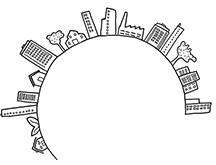Shaping the transition towards a circular economy

In recent years, the term “circular economy” has become increasingly widespread and has also reached the construction industry. There are a variety of levers for implementing the concept in the construction and real estate sector. In the report “Circular Economy – Closing loops means being fit for the future“, the DGNB has gathered these levers and addresses the relevant stakeholders whose support and participation is required for a transition towards a circular economy. Furthermore, the DGNB provides a toolbox that shows how the idea of circular economy can be realised in concrete projects in practice. Key message: the transition is actually possible, every single step counts, but we can only succeed if we cooperate.
The concept behind the circular economy is very promising: the appreciation, reuse and recovery of resources are intended to ensure their availability and quality for future generations. This requires not less than a fundamental shift: from a linear to a circular model.
The circular economy is logical – but how can the transition succeed?
In its report, the DGNB has defined several strategic fields of action that are crucial for the transition towards the circular economy. To start with, we have to take a stance for circular economy and promote the acceptance of reused components. This implies providing education and information as well as setting new trends. In addition, cooperation between relevant stakeholders in the early planning stages is very important. A contribution is not only required by planners, but also by the public sector and by manufacturers.
The prevailing uncertainty regarding the legal situation is a major obstacle to the wider dissemination of the circular economy. Assistance and clear information as well as educational services are absolutely necessary here. While legislators need to formulate and communicate clearer rules regarding reuse of components, manufacturers should evaluate new forms of warranty. Planners, in turn, should inform themselves about the current legal situation and make use of training opportunities.
Create transparency, strengthen the transfer of information
Avoiding pollutants and hazardous substances as well as an appropriate documentation of these is another strategic field of action in relation to the circular economy. This requires greater transparency with regard to the materials used. It is certainly not the right way to contaminate material flows with possible pollutant components in the recyclate and thus to shift the problem into the future. Instead, the use of alternative materials and the introduction of transparent sources of information become necessary. Universities, training institutes and further sources of specialized information are also in demand in this respect. Planners have an important role to play in informing the building owners and should furthermore provide recycling-oriented documentation. Beyond that, it is also the legislator’s turn who should, for instance, demand that pollutant analyses for current deconstruction projects should be specifically geared to recycling.
Increase the acceptance of circular economy solutions systematically and gradually
For many areas of the circular economy, the existing processes are not yet economically viable. One reason is certainly that these are not yet fully established due to the low demand. Optimising processes, making information available and bringing supply and demand together are three of the tasks presented for this field of action in the DGNB report. This does not require the big shot or the perfect solution right away. Even small steps help. Such necessary steps result, for example, for deconstruction, recycling and disposal companies, which should for their part establish higher-level take-back processes in close cooperation with manufacturers. Employees should be trained accordingly. The following applies to the public sector: it should act as a role model, for example by supporting future deconstruction through digital tools and possibly creating trans-regional platforms for this purpose.
Toolbox provides many examples of implementation
The list of strategic fields of action presented in the DGNB report and the approaches outlined therein are far from complete. The corresponding toolbox in the report provides a variety of impulses and examples for practical implementation in design. It also provides a checklist that helps to implement design aspects for conversion and deconstruction in each project in practice. The circular economy report can now be preordered as a PDF (free of charge). The toolbox will be expanded online and continuously be filled with further examples.
Achieving the goal together: Implement circular economy now!
In can be summarized that the overriding task is clear: It is all about fundamentally rethinking and transforming common practice. On the one hand, this requires clearly defined areas of responsibility and thus scope for action. It is, on the other hand, a matter of using existing knowledge and sharing it with each other. We can learn from existing solutions and adapt them to current conditions. It does not always have to be the most complex solution though; less can be more. We should put into question the status quo more often, try out new things, create experimental spaces and learn from mistakes. As Europe’s largest network for sustainable construction, the DGNB can and wants to bring together the most important players in order to move forward together on the road to a circular economy. As the title of the report says: Closing cycles means being fit for the future.





